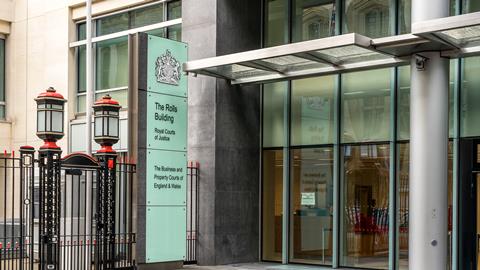Last month, the Civil Justice Council published the Enforcement Working Group’s report on how to improve the enforcement of judgments and consequential orders. The members of the working group were focused on how to make the enforcement process more efficient, economical and successful.


Such work is important: practitioners are well aware of the number of judgments that go unsatisfied and the risk that a determined defendant may see the trial as only phase one of the battle. The contribution of the working group is valuable, particularly in respect of one of its core suggestions: the proposal to form a specialist enforcement court.
Following a model that works: the benefits of a specialist court
Specialist tribunals have long been a feature of English law, and many, such as the Land Tribunal and the Technology and Construction Court (based in the Rolls Building, pictured), already exist within our court system. Given the broad success of such specialist courts, the working group’s suggestion that a new enforcement tribunal be created is welcome. All the more interesting is the report’s implication that the court could be digital, or at least a court designed for the digital age.
Practitioners are grateful for the opportunity to bring claims before judges who are subject-matter experts and steeped in the specialism in issue. That these courts can adapt rules to best serve the types of case that they see is also very valuable. Concentrating case types in one court also assists in spotting trends and responding to them.
In principle, the suggestion of a specialist enforcement court seems to follow that fine tradition. Training resources could be focused on the staff and judges who would run the enforcement court. The working group also suggests taking practical steps, such as reforming Part 71 of the Civil Procedure Rules to give the new court the procedural tools it needs. Substantive reforms are also posited (and to be welcomed), such as bringing into effect long-delayed reforms contained in the Tribunals, Courts and Enforcement Act 2007. Those reforms would allow the court, on application by the creditor, to ask government bodies to provide information regarding judgment debtors, including about their assets. It is a classic case of leveraging one part of the state which holds information in favour of another part of the state, which can be more effective when it has the information.
So, is the proposed enforcement court an all-encompassing panacea? Perhaps, but only with additions.
Cross-border focus
Assets cross borders more easily today than ever. A defendant who can see the writing on the wall will often, unless subject to a freezing injunction or similar interim order, move assets to other jurisdictions. Whether that is to make the assets less amenable to enforcement, or simply to render the enforcement more expensive, the result is the same: claimants lose out on recoveries that the court has ordered.
The new enforcement court, if it is to come into being and be as efficient as we would wish, must have strong international links and powers. Whether that is achieved through statutory reform to cross-border regimes that were designed before the advent of email, or collegial exchanges between judiciaries and more informal networks, this must not be overlooked.
Good money after bad
One of the core issues of our political era is how to maintain and improve on historically respected public services in an age of economic uncertainty. Much ink has rightly been spilt on the crucial need to restore the criminal justice system after many years of insufficient funding across the board (legal aid, enforcement agencies and the court estate itself). However, from an economic perspective, the financial damage of a civil court system where enforcement is patchy is a significant one.
There is no unlimited amount of money ready to be deployed. Further resourcing will have to come with reforms that mean services are delivered more economically. That is where the enforcement court is such an opportunity. Built to reflect the society in which it operates, the court’s potential for savings and efficiencies is obvious (for one, going entirely paperless). That is not to say it will be possible to deliver it without any cost. However, the investment in court staff, judges and a broad approach to ensuring speedy and low-cost enforcement where the substance of a dispute has already been determined will pay economic dividends.
The dedication of those who contribute to efforts such as the Working Group on Enforcement should not be underestimated. Their suggestions are both prescient and practical. A specialist court that resolves the enforcement conundrum is quite possible, but it must have the means to achieve this important goal, and the opportunity to look beyond our borders to achieve it.
Sarah Gabriel is a partner and Philip Gardner a senior associate at Peters & Peters, London
































No comments yet